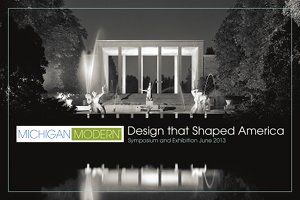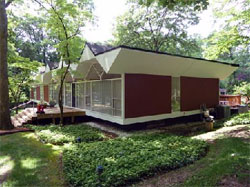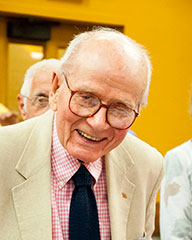Troy Michigan Based Architectural Photographer
Balthazar Korab Dies
In an announcement sent by the Michigan Chapter of the American Institute of Architects on Tuesday, January 15, 2013, the world learned of the passing of famed architectural photographer Balthazar Korab. Mr. Korab, who the subject of one of the Library of Michigan’s 2013 Notable Books Balthazar Korab Architect of Photography by John Comazzi (Princeton Architectural Press), was a trained architect but gained his greatest fame for his stunning architectural photographs.
On Friday, May 15, 2009, Balthazar Korab was presented with a Lifetime Achievement Award by MHPN. Text from that presentation is provided here.
For more than 50 years, Balthazar Korab has been recognized throughout the world as a photographer of architecture, art, and landscape. It is also Balthazar’s photographic documentation of the architecture of Michigan, and his tireless support of its recognition and preservation, that make it particularly appropriate for him to receive the Michigan Historic Preservation Network’s Lifetime Achievement Award – the twenty-fourth individual to do so in the award’s 18-year history.
Balthazar was born in 1926 in Hungary and studied architecture at the Polytechnicum in Budapest. In 1949, he fled Hungary’s communist government, emigrating to Paris where he completed his architectural studies in 1954 at L’Ecole des Beaux Arts, and where he studied art history at L’Ecole du Louvre. These studies were cap-stoned by a summer of study in Venice at Les Congres Internationaux d’Architecture Moderne.
In 1955, after stints as a journeyman under Le Corbusier and other European architects, Balthazar moved to the U.S. Eero Saarinen hired him as a designer in his Bloomfield Hill’s office at Cranbrook. Under Saarinen, Balthazar experimented not only in architectural design – receiving fourth prize in the Sydney Opera House Competition – but began his lifelong work with photography as a design tool. His contributions already were recognized by 1964 when he was awarded the American Institute of Architects Medal for Architectural Photography. By then, Balthazar had decided to stay in the U.S. and became a naturalized citizen in that same year. He had been fully embraced by the architectural community in Detroit, with many firms retaining him to document their projects. About his work, Balthazar stated, “I have always considered myself an architect who takes pictures, rather than a photographer who is knowledgeable about architecture.”
In addition to Saarinen, Balthazar has worked with some of the world’s most important architects including Louis Sullivan, Frank Lloyd Wright – who invited him to join Taliesin in 1958, Le Corbusier, Louis Kahn, Harry Weese, Frank Gehry, Marcel Breuer, Minoru Yamasaki, Ludwig Mies van der Rohe, Philip Johnson, Cesar Pelli, and I.M. Pei. His photographic work has been in dozens of exhibits and is found in public and private collections including the Detroit Institute of Arts, the Museum of Modern Art in New York, the U.S. Library of Congress, and Montreal’s L’Centre Canadien d’Architecture. He also has been featured in a number of publications, most recently the Michigan Architectural Foundation’s text, Great Architecture of Michigan.
We are extraordinarily proud that Balthazar and his wife Monica chose to make their home in Michigan and raise their children Christian and Alexandra here. The couple resides in Troy on a four-acre historic homestead where they operate his photography studio. Balthazar has been committed to his State serving on the Governor’s Committee on Art in Public Places, as Design Editor of Metropolitan Detroit, and on the Design Advisory Committee for Cranbrook. And he has been recognized for this commitment with Honorary Memberships in the Michigan Society of Architects, the AIA Detroit Chapter, and the Michigan Society of Landscape Architects. In 1994, then-President Bill Clinton presented a hand-selected portfolio of Balthazar’s photography to Arpad Goncz, the President of Hungary, on his state visit to Budapest. Most recently in 2007, Balthazar received both the AIA Lifetime Achievement Award for Photography, and, the Hungarian Institute of Architects’ Honorary Award for Lifetime Achievement.
Of his work, Balthazar states, “I am an architect with a passion for nature’s lessons and man’s interventions. My images are born out of a deep emotional investment in their subject.” We are deeply appreciative that Balthazar Korab has joined us this evening to receive the Michigan Historic Preservation Network’s Lifetime Achievement Award.
This press release is from the Michigan Historic Preservation Network.
The MHPN is Michigan’s statewide preservation organization and the advocacy and resource group for preservationists from all backgrounds. Founded in 1981 to foster the preservation and protection of Michigan’s rich cultural and architectural heritage, MHPN has led the effort to strengthen the Local Historic District Act [P.A. 169 of 1970 (as amended)] and worked to establish a Michigan Historic Tax Credit that, for over ten years, helped revitalize historic and traditional communities throughout the state. For more information about MHPN and its annual awards program, now in its 22nd year, please visit our website at: www.mhpn.org.







